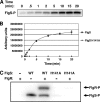Activation of the Campylobacter jejuni FlgSR two-component system is linked to the flagellar export apparatus
- PMID: 19201799
- PMCID: PMC2668382
- DOI: 10.1128/JB.01689-08
Activation of the Campylobacter jejuni FlgSR two-component system is linked to the flagellar export apparatus
Abstract
Activation of sigma(54)-dependent gene expression essential for formation of flagella in Campylobacter jejuni requires the components of the inner membrane-localized flagellar export apparatus and the FlgSR two-component regulatory system. In this study, we characterized the FlgS sensor kinase and how activation of the protein is linked to the flagellar export apparatus. We found that FlgS is localized to the C. jejuni cytoplasm and that His141 of FlgS is essential for autophosphorylation, phosphorelay to the cognate FlgR response regulator, motility, and expression of sigma(54)-dependent flagellar genes. Mutants with incomplete flagellar export apparatuses produced wild-type levels of FlgS and FlgR, but they were defective for signaling through the FlgSR system. By using genetic approaches, we found that FlgSR activity is linked to and downstream of the flagellar export apparatus in a regulatory cascade that terminates in expression of sigma(54)-dependent flagellar genes. By analyzing defined flhB and fliI mutants of C. jejuni that form flagellar export apparatuses that are secretion incompetent, we determined that formation of the apparatus is required to contribute to the signal sensed by FlgS to terminate in activation of expression of sigma(54)-dependent flagellar genes. Considering that the flagellar export apparatuses of Escherichia coli and Salmonella species influence sigma(28)-dependent flagellar gene expression, our work expands the signaling activity of the apparatuses to include sigma(54)-dependent pathways of C. jejuni and possibly other motile bacteria. This study indicates that these apparatuses have broader functions beyond flagellar protein secretion, including activation of essential two-component regulatory systems required for expression of sigma(54)-dependent flagellar genes.
Figures






Similar articles
-
A regulatory checkpoint during flagellar biogenesis in Campylobacter jejuni initiates signal transduction to activate transcription of flagellar genes.mBio. 2013 Sep 3;4(5):e00432-13. doi: 10.1128/mBio.00432-13. mBio. 2013. PMID: 24003178 Free PMC article.
-
FlhF and its GTPase activity are required for distinct processes in flagellar gene regulation and biosynthesis in Campylobacter jejuni.J Bacteriol. 2009 Nov;191(21):6602-11. doi: 10.1128/JB.00884-09. Epub 2009 Aug 28. J Bacteriol. 2009. PMID: 19717591 Free PMC article.
-
Restoration of flagellar biosynthesis by varied mutational events in Campylobacter jejuni.Mol Microbiol. 2008 Oct;70(2):519-36. doi: 10.1111/j.1365-2958.2008.06428.x. Epub 2008 Aug 29. Mol Microbiol. 2008. PMID: 18761684 Free PMC article.
-
Motility and chemotaxis in Campylobacter and Helicobacter.Annu Rev Microbiol. 2011;65:389-410. doi: 10.1146/annurev-micro-090110-102908. Annu Rev Microbiol. 2011. PMID: 21939377 Free PMC article. Review.
-
Type III flagellar protein export and flagellar assembly.Biochim Biophys Acta. 2004 Nov 11;1694(1-3):207-17. doi: 10.1016/j.bbamcr.2004.04.005. Biochim Biophys Acta. 2004. PMID: 15546667 Review.
Cited by
-
Sense and sensibility: flagellum-mediated gene regulation.Trends Microbiol. 2010 Jan;18(1):30-7. doi: 10.1016/j.tim.2009.11.001. Epub 2009 Nov 26. Trends Microbiol. 2010. PMID: 19942438 Free PMC article. Review.
-
Extracellular secretion of protease HtrA from Campylobacter jejuni is highly efficient and independent of its protease activity and flagellum.Eur J Microbiol Immunol (Bp). 2013 Sep;3(3):163-73. doi: 10.1556/EuJMI.3.2013.3.3. Epub 2013 Sep 23. Eur J Microbiol Immunol (Bp). 2013. PMID: 24265934 Free PMC article.
-
Diversification of Campylobacter jejuni Flagellar C-Ring Composition Impacts Its Structure and Function in Motility, Flagellar Assembly, and Cellular Processes.mBio. 2020 Jan 7;11(1):e02286-19. doi: 10.1128/mBio.02286-19. mBio. 2020. PMID: 31911488 Free PMC article.
-
A specificity determinant for phosphorylation in a response regulator prevents in vivo cross-talk and modification by acetyl phosphate.Proc Natl Acad Sci U S A. 2011 Dec 13;108(50):20160-5. doi: 10.1073/pnas.1113013108. Epub 2011 Nov 29. Proc Natl Acad Sci U S A. 2011. PMID: 22128335 Free PMC article.
-
FdhTU-modulated formate dehydrogenase expression and electron donor availability enhance recovery of Campylobacter jejuni following host cell infection.J Bacteriol. 2012 Aug;194(15):3803-13. doi: 10.1128/JB.06665-11. Epub 2012 May 25. J Bacteriol. 2012. PMID: 22636777 Free PMC article.
References
-
- Akerley, B. J., and D. J. Lampe. 2002. Analysis of gene function in bacterial pathogens by GAMBIT. Methods Enzymol. 358100-108. - PubMed
-
- Baker, M. D., P. M. Wolanin, and J. B. Stock. 2006. Signal transduction in bacterial chemotaxis. Bioessays 289-22. - PubMed
-
- Black, R. E., M. M. Levine, M. L. Clements, T. P. Hughes, and M. J. Blaser. 1988. Experimental Campylobacter jejuni infection in humans. J. Infect. Dis. 157472-479. - PubMed
Publication types
MeSH terms
Substances
Grants and funding
LinkOut - more resources
Full Text Sources

